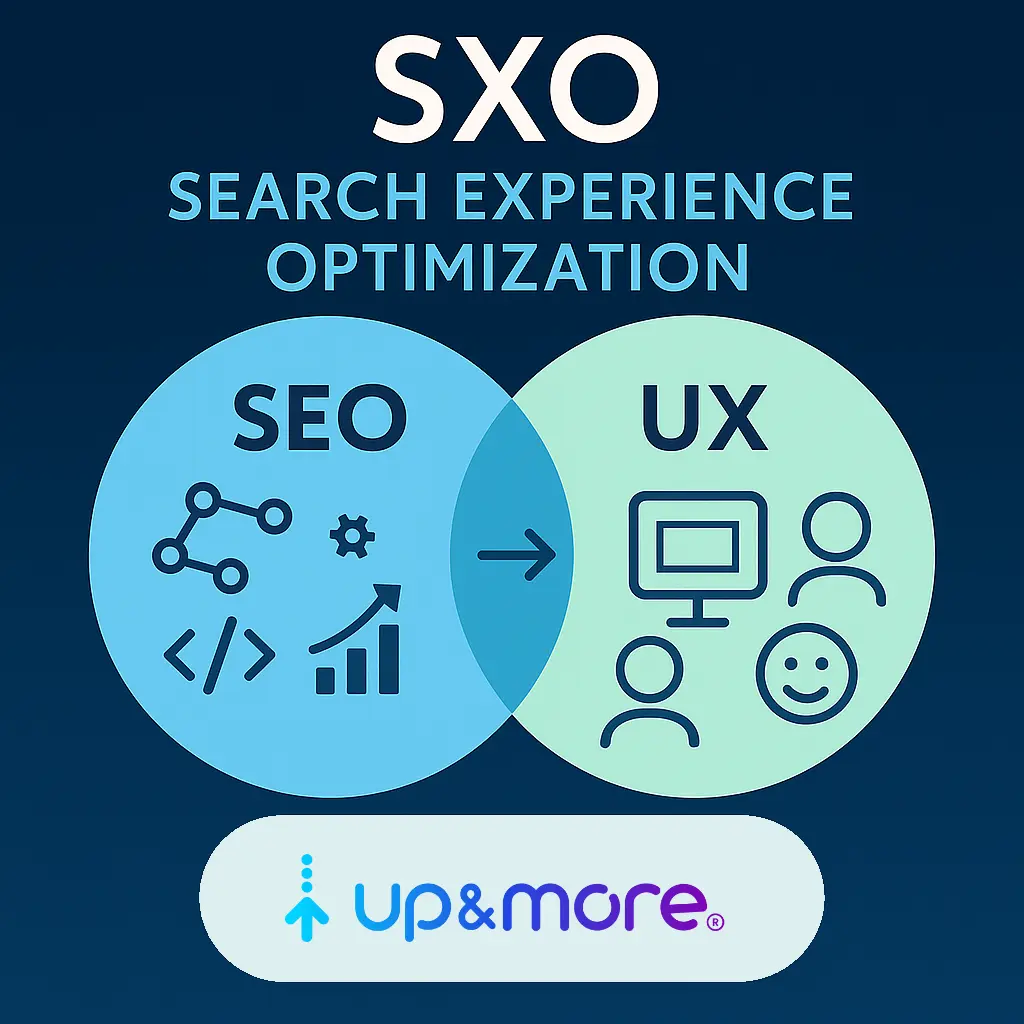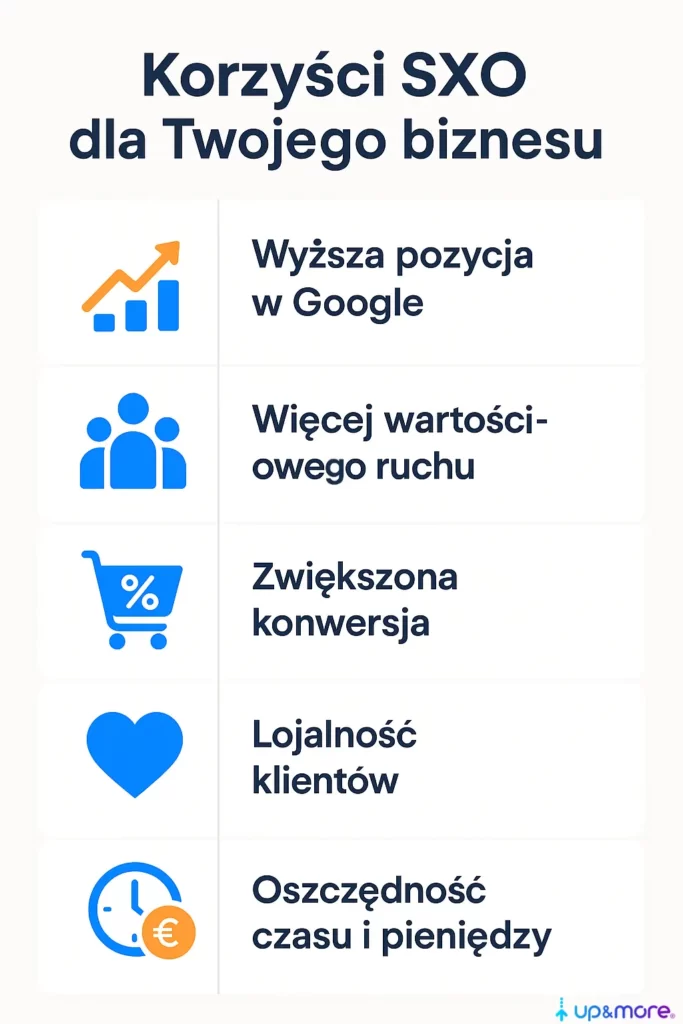Table of contents
SXO, or Search Experience Optimization, is a combination of the best in online marketing – effective SEO and user-friendly experience (UX). Imagine your website not only getting top rankings on Google, but also holding your visitors’ attention like a good series on Netflix. Sounds good, doesn’t it?
In practice, SXO means comprehensive measures that make your site attractive to both search engine algorithms and users. As a result, you get more valuable traffic, higher conversions and customer loyalty, and save time, money and nerves at the same time.
In this article, we explain exactly how SXO differs from classic SEO, why UX optimization is crucial today, how an SXO audit works and what specific benefits it can bring to your business. Finally, we also reveal how artificial intelligence (AI) and Google’s new approach – Search Generative Experience (SGE) – are changing the rules of the game, and why SXO will be even more important in the coming years.
If you want your website to be prepared for the future and not fall behind the competition – be sure to read on!
What is SXO?
SXO (Search Experience Optimization) is a combination of SEO (Search Engine Optimization), or search engine optimization, and UX (User Experience), or user experience optimization. Put simply, SXO is a strategy to make your website not only high in Google, but also friendly and convenient for visitors. Sounds good, right?

SXO versus SEO – what are the differences?
SXO is a broader term and includes SEO. Like classic SEO, SXO focuses on increasing organic traffic, i.e. traffic acquired from search engines. There are still on-site activities (optimization of content, meta tags, internal links) and off-site activities (acquiring valuable external links).
But there is one important difference: SXO does not end with bringing a user to the site. It’s just the beginning. Because what’s the use of getting someone to your site if they immediately flee from it?
How does UX help turn visitors into customers?
User experience (UX) optimization are activities that make using a website easy, intuitive and enjoyable. UX encompasses everything from the site’s design (UI), to content, to purchasing processes and interactions.
With good UX, a user will not only stay on the site longer, but will also be more likely to make a purchase or fill out a contact form. Even if the number of visitors doesn’t change, improving UX can significantly increase the conversion rate. And after all, that’s what it’s all about, isn’t it?
Why SXO is the perfect combination of SEO and UX?
Google has been officially taking user experience into account when determining a site’s position in search results since 2021. This means that the better the UX, the higher your site will rank in Google. In turn, higher rank means more visitors, and better UX means more conversions. Simple, right?
Is SXO the future of Internet marketing?
Yes, competition is growing, products and services are getting better and better, and customers are becoming more demanding. Today, it’s no longer enough to have a good product – you need to have a great user experience. SXO is precisely the answer to these needs. In the future, the importance of SXO will only grow, so it’s worth getting started now.
Does SXO save time and money?
Yes, and quite a lot. By combining SEO and UX activities into one cohesive strategy, you save time and money. If one agency takes care of comprehensive SXO optimization, the whole process will go faster, more efficiently and cheaper. And you’ll see results faster than with separate SEO and UX efforts.
How often is it a good idea to perform SXO optimization?
SXO, like SEO and UX, produces long-term results. But remember – users’ needs change, trends evolve, and competitors don’t sleep. That’s why it’s a good idea to repeat the SXO audit regularly and make the necessary adjustments. This will ensure that your website will always be up to date and meet the expectations of customers.
What is a SXO audit?
A SXO audit is a comprehensive analysis of a website in terms of SEO and UX. Specialists check numerous parameters, some of which you will find below broken down into SEO and UX audits.
SEO and Analytics Audit
- domain history,
- keyword analysis,
- visibility in Google,
- internal and external linking,
- correctness of analytics configuration,
- parameters of organic traffic and conversions.
UX audit
- expert analysis (cognitive hike, heuristic analysis),
- analysis of user behavior (heat maps),
- page loading speed,
- quality and layout of content,
- intuitiveness of user experience.
All of this is analyzed from the user’s perspective – because it is the user’s experience that determines the success of your site.
What do you get after an SXO audit?
Audit ends with a report that clearly identifies problems and recommendations to solve them. Each problem is assigned a severity – from critical to minor fixes. A good report also points out the strengths of the site, so that you don’t accidentally mess them up during optimization.
Why implementing SXO recommendations is important?
The audit itself is only the beginning. The key is to implement the recommendations. It’s best to outsource this to the same agency that conducted the audit – this will make the whole process faster, cheaper and more accurate.
What are the benefits of SXO?
SXO (Search Experience Optimization) brings real benefits that you will feel not only in your Analytics statistics, but also in sales results and satisfaction of users visiting your site. What specifically do you gain by betting on SXO?
- Higher visibility in Google – SXO, like SEO, helps your site climb higher in search results. Better position = more visits.
- More valuable traffic – You acquire not only more users, but more importantly users interested in your offer. The right keyword phrases and tailored content attract the right customers.
- Longer time spent on the site – Users are more likely to stay where they feel comfortable. With UX/UI optimization, your website becomes comfortable, intuitive and inviting to browse more pages.
- More conversions and better CRO – SXO is not just about traffic, it’s all about conversions. Attention to UX and optimization of purchase paths directly increases the number of sales, newsletter signups or contact forms sent.
- Customer loyalty – A good user experience makes visitors more likely to return, and your brand begins to be associated positively. This is the foundation for building a loyal community around your site.
- Saving time and money – Comprehensive SXO optimization avoids splitting your marketing efforts between different companies. One strategy and one agency means lower costs, faster results and better consistency.
- Long-term effects – SXO effects don’t disappear immediately after the campaign ends (as is the case with paid advertising, for example). They are permanent and ensure stable development of your site for a long time.

Is SXO related to AI and Search Generative Experience?
Recently, we’ve been hearing more and more about AI (artificial intelligence) and Google’s new approach called Search Generative Experience (SGE). Do these trends have anything to do with SXO? Definitely yes!
What is Search Generative Experience (SGE)?
SGE is Google’s new way of presenting search results, which uses AI to generate more elaborate and precise answers directly on the search engine page. Google doesn’t just show links, but also creates and presents answers to the user’s questions on its own. That’s what the Search Generative Experience is.
How AI and SGE affect SXO?
Here’s how AI and SGE relate to SXO:
- Increased role of valuable content – Search engine AI applications mean that Google is becoming more effective at evaluating the quality of content. Content must not only be optimized for keywords, but most importantly useful, tailored to the user’s needs, and answering questions in a natural and detailed way.
- User intent comes first – AI allows us to better understand user intent. SXO focuses precisely on optimizing the site for the specific needs of visitors. By integrating AI with SXO, you more effectively reach users who are actually interested in your offer.
- Personalizing the experience – AI helps personalize the user experience, and this aligns perfectly with SXO’s focus. With AI, you can better tailor your content, visual messaging and offers to the individual needs of the visitor.
- Dynamic UX optimization – AI gives you the ability to analyze massive amounts of data on user behavior. This gives SXO the tools to respond instantly to users’ needs, optimizing UX in real time.
To put it simply – AI and SGE are not competitors to SXO, but its natural extension. In the future, positioning and optimization of user experience will be increasingly based on advanced data and artificial intelligence. SXO, by integrating with AI, will be even more effective and tailored to the changing needs of users.
So if you want your website to be ready for the future, it’s worth betting on comprehensive SXO optimization with AI-based solutions now. After all, as they say in the industry: how many letters does the word success have? Three. SXO! (And sometimes AI too 😉)

Was the article helpful?
Rate our article, it means a lot to us!
Let's talk!
Hello! My name is Piotr Starzynski and it's a pleasure to meet you in the SEO industry. I have been officially working in SEO since 2006, while I have been working in analytics for several years. I have about 400 analytics implementations for client websites, hundreds of SEO projects and dozens of analytics projects for mobile applications. At Up&More, I am responsible for the Search Engine Optimization and Web Analytics team. If you feel like working with me, I invite you to contact me!